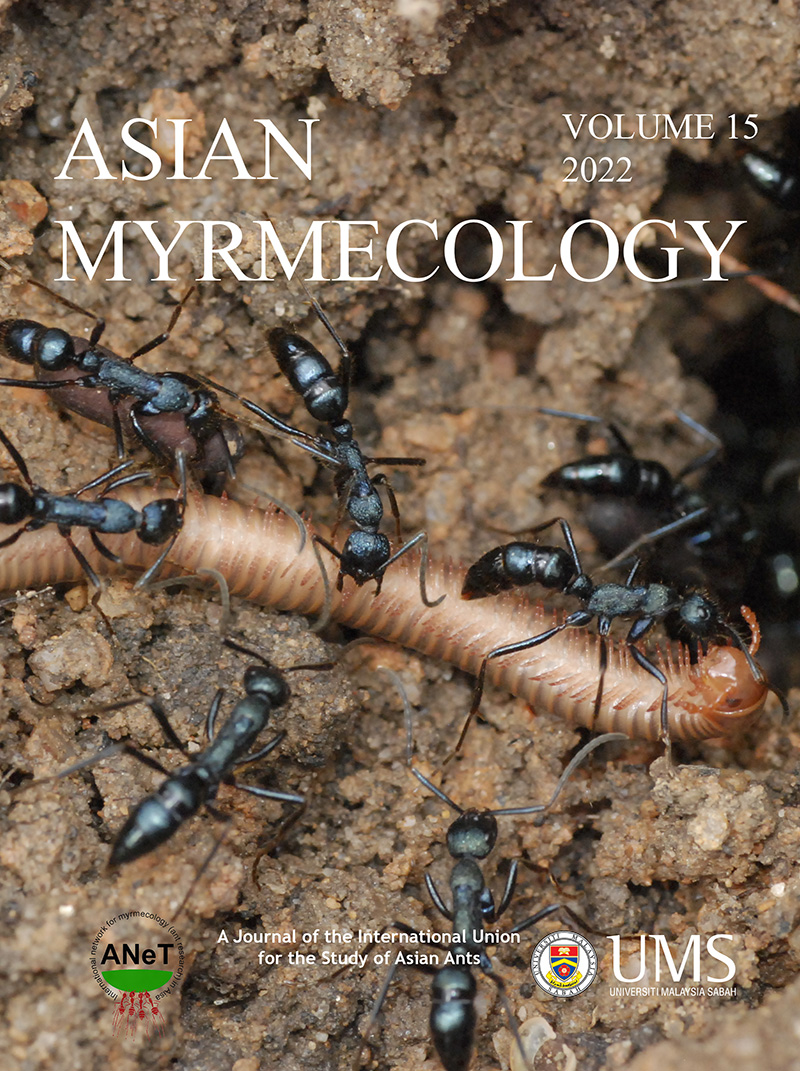ASIAN
MYRMECOLOGY
Image: François Brassard
DOI: 10.20362/am.016006
Asian Myrmecology 16: 016006 (1-6)
article first published online: 12/May/2023
Thelytokous parthenogenesis in dealate queens of the ponerine ant Anochetus shohki
SATOSHI MIYAZAKI1,2,3
Abstract:
Two orphan colonies of Anochetus shohki were collected from Yonaguni Island, Okinawa, Japan. Alate queens emerged from one of the orphan colonies, which had cocoons at the time of field-sampling. These queens exhibited an enlarged pronotum, which is a trait typical of non-claustral foundresses. They shed their wings in a few days, and then started laying eggs 24 days later. These eggs eventually developed into workers. After some of these workers eclosed, dissections revealed that queens possessed well-developed ovaries with six ovarioles (3 + 3) and workers lacked ovaries. Spermathecae of these queens were empty, and no males emerged during the study period. These findings indicate that uninseminated dealate queens in A. shohki can produce workers via thelytokous parthenogenesis, at least in orphan colonies. This represents the first report of thelytoky not only in Anochetus but also in the Ponerini tribe, and it is the second such report in the Ponerinae subfamily.
Keywords:
thelytoky, alate queen, Ponerinae, ovary
Get PDF (8.9 MB) :
SATOSHI MIYAZAKI1,2,3
Abstract:
Two orphan colonies of Anochetus shohki were collected from Yonaguni Island, Okinawa, Japan. Alate queens emerged from one of the orphan colonies, which had cocoons at the time of field-sampling. These queens exhibited an enlarged pronotum, which is a trait typical of non-claustral foundresses. They shed their wings in a few days, and then started laying eggs 24 days later. These eggs eventually developed into workers. After some of these workers eclosed, dissections revealed that queens possessed well-developed ovaries with six ovarioles (3 + 3) and workers lacked ovaries. Spermathecae of these queens were empty, and no males emerged during the study period. These findings indicate that uninseminated dealate queens in A. shohki can produce workers via thelytokous parthenogenesis, at least in orphan colonies. This represents the first report of thelytoky not only in Anochetus but also in the Ponerini tribe, and it is the second such report in the Ponerinae subfamily.
Keywords:
thelytoky, alate queen, Ponerinae, ovary
Get PDF (8.9 MB) :
1College of Agriculture, Tamagawa University, Machida, Tokyo 194-8610, Japan
2Graduate School of Agriculture, Tamagawa University, Machida, Tokyo 194-8610, Japan
3Honeybee Science Research Center, Tamagawa University, Machida, Tokyo 194-8610, Japan
*Corresponding author: smiyazaki@agr.tamagawa.ac.jp



